TMW #102 | Twitter’s demise in a post-social world
Welcome to The Martech Weekly, where every week I review some of the most interesting ideas, research, and latest news. I look to where the industry is going and what you should be paying attention to.
👋 Get TMW every Sunday
TMW is the fastest and easiest way to stay ahead of the Martech industry. Sign up to get the full version delivered every Sunday for this and every TMW, along with an invite to the TMW community. Learn more here.
What if I told you...
.....That you can now try TMW PRO for free?
Subscribers gave me a ton of feedback this week (thank you) and one thing that came up was having a chance to get the newsletter and try the TMW vault before buying. Well... now you can!
Twitter’s demise in a post-social world
It finally happened, Elon acquired Twitter for $44 billion, fired the executive team and half the company’s staff, and started rolling out new features - all in the first few days. This week Twitter’s main character has been well… Twitter. Between the endless discussion, critique, and user scheming to move elsewhere, there’s been nothing but noise as the bird app goes through its most tumultuous period of change in the company’s history.
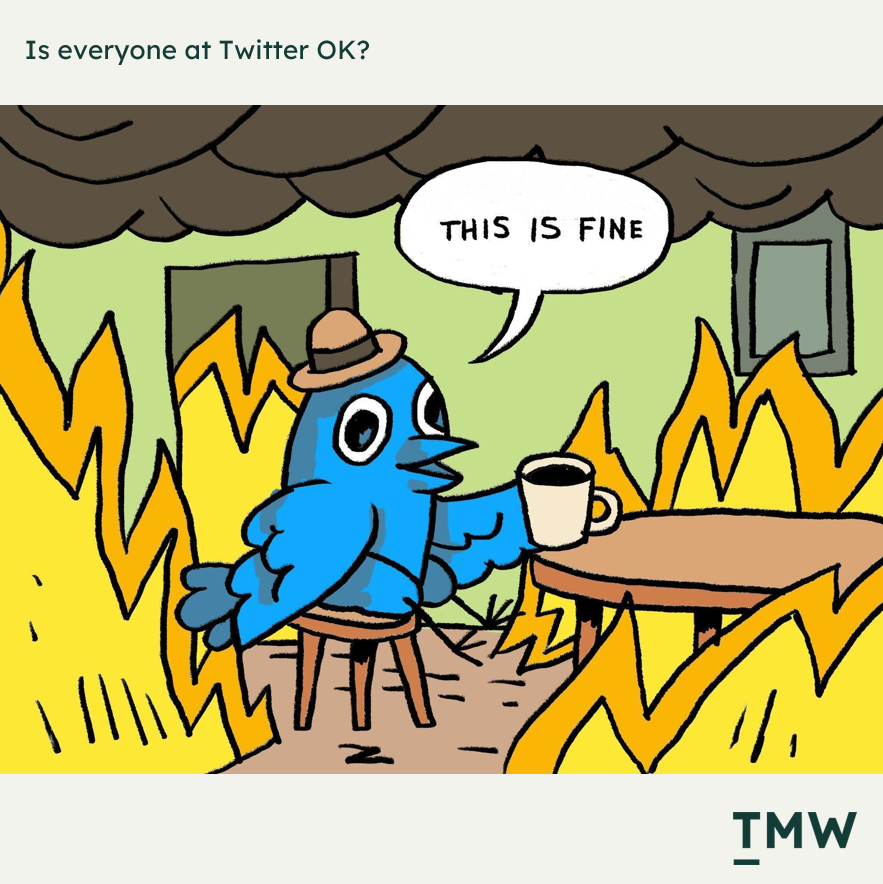
That said, I don’t want to focus only on Elon Musk, or Twitter. Instead, I want to situate the changes to Twitter in the context of social media’s long decline in the West. Recently I wrote an essay called late-stage social media. The below excerpt frames social media as a transition from creation to attention-focused goals, the Twitter acquisition is symptomatic of this change.
"Social media today has replaced creation and connection with attention as its primary goal. One of the most interesting things about late-stage social media has been its ability to change what most people want out of internet socializing. All the platforms founded around 2005 significantly changed the user experience from freeform creative expression to uniformity and constraint. It’s one of the main reasons these platforms scaled, where many didn’t. The most successful social networks turned everything into a popularity contest."
The popularity contest
But now, with the acquisition of Twitter, the situation is worse than it seems across all major social media platforms. Meta and Google, the two platforms with the largest share of social media users and ad revenue, are facing historically low stock prices in the market.
There’s pressure coming from all angles. Google hasn’t shipped anything consumer-facing that landed for years, Meta’s attempt to do something new in VR is quickly turning into a multibillion-dollar money pit triggering activist investor open letters. Apple’s ATT and privacy relay is cutting off the data needed for ad products, government regulation is a constant risk, and to top it off TikTok is taking up a more significant market share with every passing week.
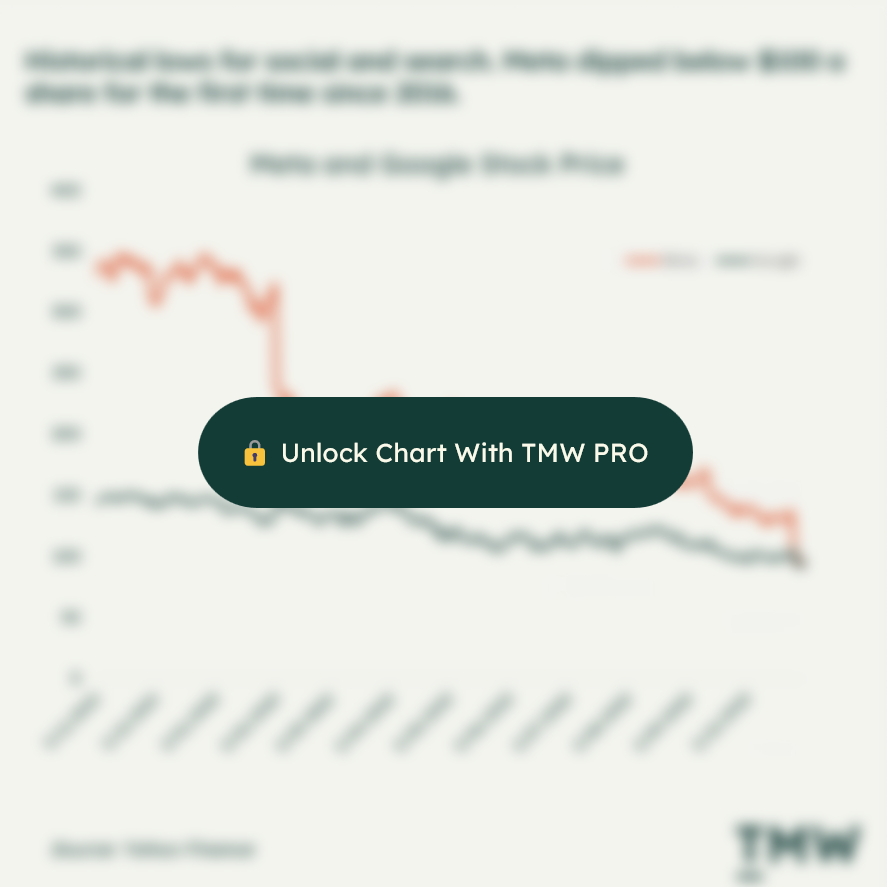
Regardless of what you think of the takeover, Twitter is one of the most popular social media apps for powerful people in the world. No other network is quite like it in its cultural sway over American discourse, and this has significant potential for a turnaround after years and years of stagnation on the platform. Twitter won the political popularity contest and because of this, the platform has become increasingly hostile to its user base.
Now, Elon wants to de-pollute the bird app (through paid account verification) and somehow enhance how Twitter works for people. So far, the features include better Twitter search, promotion of content for paid users, longer-form video, and potentially the revival of Vine. All of the above appears to be a disconnected string of tactical changes lacking a guiding vision outside.
Twitter’s cultural influence far outpaces its commercial promise and Elon knows that. This is about the popularity contest that social media networks have become in recent years. Driven by personality and a direct connection with fans, other celebrities like Ye and Trump now own their own (albeit small) social networks. Influence is one hell of a drug.
Returning to the concept of late-stage social media, before the announcement of Elon’s plan for paid verification I said this:
There is a glaringly obvious gap in the social medial landscape. Everyone now knows what it means to use social media. We don’t really need to educate people on the value and usability of social platforms, people just get it. This is why a paid version of social media is very much needed. If a social app can reach scale by offering users an environment free of bots, harassment, and features that enhance creativity and connection there’s a slim chance that another app can make it into the company of the social media giants.
The argument here is that the need for marketers to drive growth has over-influenced the social media landscape to prioritize attention over a connection with the kinds of behaviors these platforms incentivize for users. It’s interesting that Elon wants users to pay for the service. And I agree that it may just make Twitter a better place to do social media.
Right now the $8 upgrade to Twitter Blue came out as a half finished release, but I think there is some value in a social network that’s not completely aligned with advertising incentives (see LinkedIn). Driving a substantial base of users to upgrade may be part of reducing the app’s reliance on advertisers. But so far, nothing suggested by Elon solves the content moderation problem, nor does it add much by the way of introducing new people to the social media network.
The downward spiral
Social media in the West has been on an ongoing path into irrelevance and increasing animosity toward users. This is not a surprise in any way, any platform that derives most of its revenue from the monetization of attention through advertising will increasingly optimize for the true customer. Over time, social media adoption in the US has continued to grow, but nowhere near the levels ten years ago. We’re living in a post-social media world.
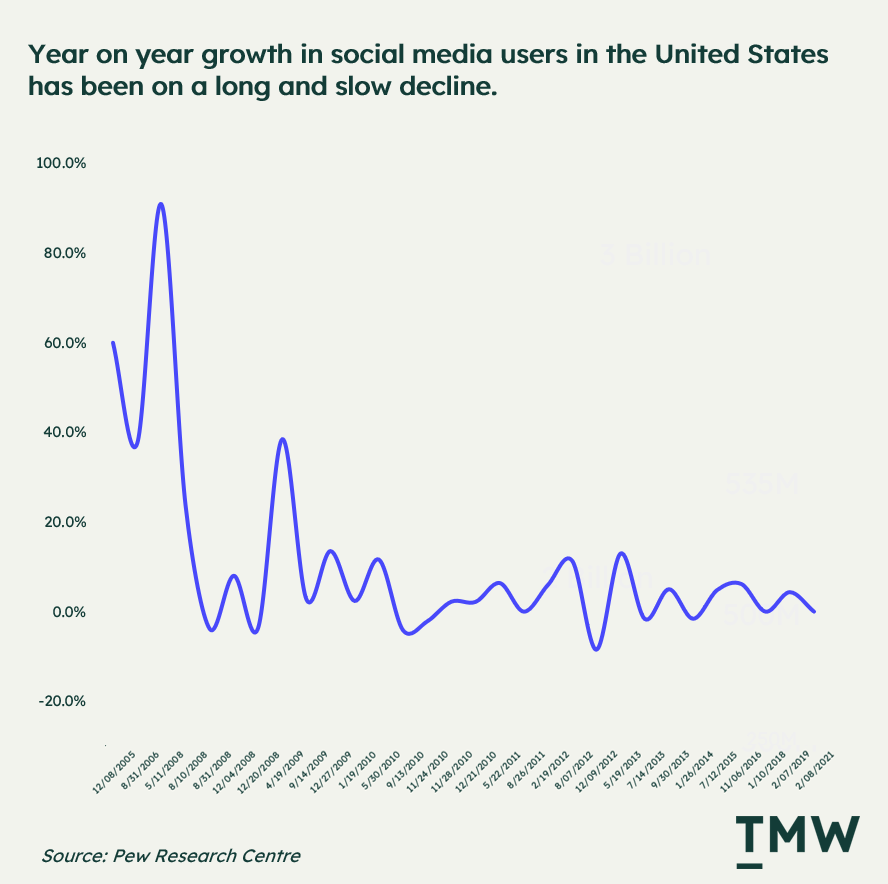
This is clearly seen in the ways social media algorithms try to tailor content to you, how divisiveness continues to drive engagement and users, and how content is optimized by a platform’s own users to suck people into conspiracy theories, pointless arguments, or into purchasing things they don’t need.
That’s the problem with social networking in 2022, most of it is increasingly hostile content designed to stimulate the bottom of our brainstems. In many ways, the COVID-19 pandemic was a temporary glitch in this downward spiral by forcing people to connect on major social networks without much by way of options.
Scott Galloway this week argues that the continued interest in advertising on social media platforms is only declining. The acquisition of Twitter by Elon, and also Kanye’s acquisition of far-right Parler goes to show that social networks are becoming easier to manage as they become commodified technologies.
This is why Elon wrote his open letter to advertisers – many brands are dropping media spend because they're concerned about brand safety. Why is Elon saying this? The value of Twitter is not in the technology - it’s the content. When the first networks came online, the value proposition was in the technology, building it was the important thing. Now, late-stage social media’s value lies in the content and who’s on which platforms.
Despite the rise of TikTok, there’s nothing innovative about social networking in 2022. It’s mostly remixing existing models of engagement (algorithmic content feed, content personalization, tools to interact with one another, and ways to create). TikTok is just a fresh iteration in what is now entrenched behaviors – they just do it without caution, faster, and with a format (video) that is far more engaging.
What’s surprising about social networks is the continued increase in spending in R&D. This kind of spending is an area that should lead to more innovation and change in the social landscape, but in reality, it’s been the same formats and incrementally optimized algorithms for ten years. Where does all that money go?
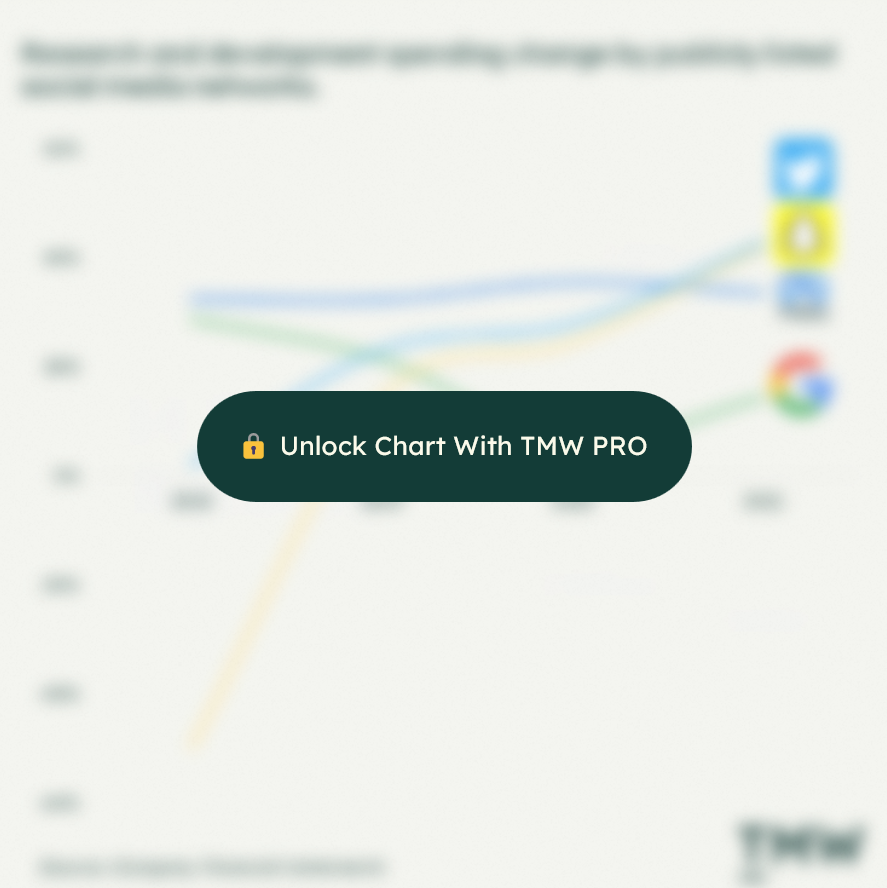
The mainstay platforms are all in various stages of entropy - too big and political to enact innovative change, and too entrenched in legal disputes and managing complex content moderation operations to really go beyond what’s been built. Outside of Meta’s expensive “bet the farm” gamble on Horizon World’s VR and Oculus, it just seems like all other social platforms have given up – there’s not much more to expect. Can Elon change that? It’s a big fat $44 billion maybe.
The social landscape is changing
Social media is changing and not in the ways we perhaps think. In a way, social networking has never been more diverse with ideas to create new patterns of connections, but in other ways, the large monopolies in this domain are on an ever-declining path as users flee and advertisers go elsewhere. Right now, we’re stuck between the old thing and the new thing.
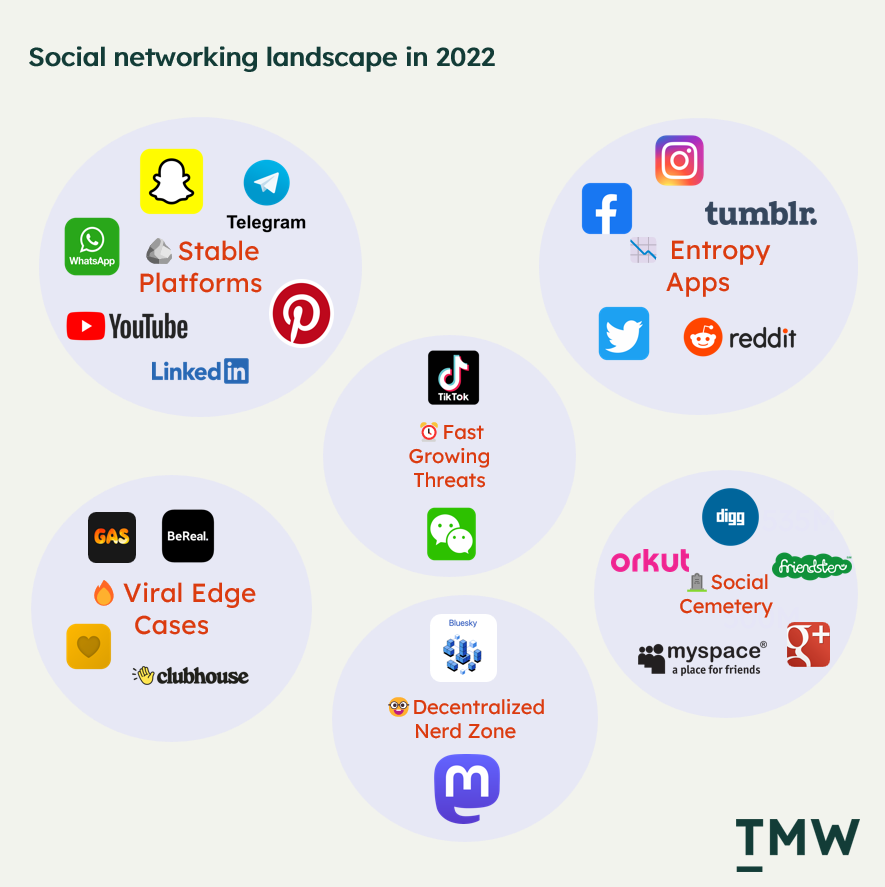
A possible way forward is decentralization. As many people were angry about Elon’s actions and concerned with the direction Twitter is heading, people went to Mastodon, an open source (federated) social network that kind of works like email – you setup a handle, join a server (owned and managed by random, unverified people) and you can start posting ridiculous things like “toots” which is just a weird name for posts. The fundamental experience design of Mastodon is very similar to Twitter (as is far-right social app Parler, and Truth Social). But there are challenges.
So far, people fleeing Twitter to join Mastodon don’t see a future in it. There’s too much complexity. It’s as if Twitter is Windows and Mastodon is Linux – it’s for the power users. And herein lies the problem with decentralizing anything – it introduces friction for users who don’t want to have to set up servers or go through complex multi-step flows just to create an account. People want no friction, a reliable experience and to build audiences where the people are.
Funnily enough, on the eve of the Elon Musk takeover, Jack Dorsey launched beta users for a new “decentralized” social network, called Bluesky. The idea is to do something like Mastodon by allowing users to connect with people across a variety of social networks, giving them choice over the algorithms they use and holding portability with their social identities. Bluesky is the right name for a project like this – building a decentralized protocol like Email or SMS for social media is an interesting idea, but all the incentives are working against it.
On the other edge of social media are all the one-hit wonders that function like feature factories for larger platforms. A few examples are the new high school viral app GAS, the BeReal photo-sharing app, and Locket which leverages iPhone widget features.
Gas is perhaps one of the most interesting because of its growth. The app has been in the top 3 downloaded apps in the app store for weeks driving millions in revenue and both paid and free users are growing exponentially less than four weeks after launching. It’s only available in select states in the US, but its concept is very different from what we’re used to in social media.
The app targets teenagers in schools and offers a way for people to complement each other in a very controlled manner (through surveys). The app leverages what others think about you by asking you things like “who’s the most beautiful person you’ve ever met” which is superficial at best and reinforces toxic positivity at worst.
Clubhouse was another interesting angle on the social web, but because it was partially fueled by technology hype and the need to connect with others during lockdowns the app tried to leverage audio content and conversations as a new social format. But the problem with audio is that people need to have time to listen to it - you can’t catch it mid-stream.
The live format was terrible to monetize with ads, and it quickly got overrun with spammers without any kind of algorithmic content curation. This one too tried an attempt at the holy grail of social media ubiquity and it failed.
These apps seem to have fast and viral user growth but cannot stand the test of time because the format is on the edges of mainstream social media use. BeReal asks you to take a front and back photo at random times of the day, while Locket is just a place to receive photo messages on your iPhone home screen. These apps are interesting experiments, but they lack any real challenge to algorithmically driven social platforms.
There are some stable platforms that somehow defy the constant change in the social media environment with consistent user and revenue growth. YouTube is perhaps the longest-standing social platform, that has maintained a top 3 spot in overall users and revenue growth over the past 15 years.
Pinterest, Snapchat, and LinkedIn are all incredibly stable for what they offer and continue to bring people back because of their utility – they don’t only rely on social interaction as a primary value proposition. Accessing content (Youtube), storing and sharing it (Pinterest), and finding a job (LinkedIn) are all great reasons for users to find value outside of social connections.
All the platforms in an entropy state of revenue and user decline rely significantly on users posting content constantly. While TikTok is currently growing faster than any other social media app in the world right now, it’s an external threat, and there’s a good chance that it will be banned from Western app stores. But as all things go, TikTok as a platform will increasingly underserve the user in favor of driving engagement for advertisers.
Marketers defined the social media landscape that we have today through their ad dollars. It’s a reality that we must live with as social networking becomes less effective for marketers and advertisers as some platforms slowly die, while others become too chaotic and risky to engage with.
I’m optimistic that Elon can make Twitter a better platform for people to build audiences and engage with others. But with social networks, over time you do pass a point of no return – no tactical changes will influence the overall direction of social networking entropy. Instead of making Twitter better, we should be searching for new social paradigms that are friendly to marketers and users alike.
Stay Curious,
Make sense of marketing technology.
Sign up now to get TMW delivered to your inbox every Sunday evening plus an invite to the slack community.
Want to share something interesting or be featured in The Martech Weekly? Drop me a line at juan@themartechweekly.com.
